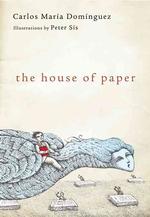good news for people with 8.29 years of schooling

Here's a fun little tool that allows you to test any website for readability. So I checked our latest posts out vs. the Decision Science News site, which definitely leans a little more academic, and the results came out as expected. My understanding of the system is that the Gunning Fog is the most telling number -- a rough estimate of the years of schooling a reader would need to understand. Someone needs 8.29 years of school to read and understand this site in its current form.
I've also taken the advice of reading weird shit from Richard H. to heart. This short story caught my eye at the library and it was well worth the read. It's an incredibly engaging tale about the love affair people have with books.

Here's a page from The House of Paper on pathways in books... a concept built around readability and the advantage of keeping it simple (like when writing a brief):
"'...a printed page is also a complicated drawing. It's a play of lines and tiny figures that flows from vowel to consonant, obeying its own laws of rhythm and composition, all based on the type size, the chosen font... candlelight lends a book an extra luster that brings out values and subtleties in a magical way. And the pathways become a delight.'
'What are pathways?' I asked...
'Well, that's an age-old discussion... nobody can be really sure whether it's the author's genius or the skill of the printer... for many readers, it's enough for them to look at the pathways to know whether a book is good and should be read.'
Delgado went over to one of his bookcases, took out an antique edition of Eugenie Grandet, and handed it to me. He told me to open it at any page and to look for vertical or diagonal channels created by the spaces between words. And it was true, I could see long pathways that led from line to line, crossed paragraphs, occasionally came to a halt, then branched off diagonally, from right to left or left to right, or cascaded vertically down.
'A writer who has no rhythm to his sentences cannt create that. If he mangles the language by putting two or three words with more than four syllables in a single sentence, he is bound to block the pathway and destroy the rhythm...'"
The readability numbers and the idea of pathways get at the same idea, but thinking about readability in terms of pathways is so much more engaging than looking at readability numbers or scores.
If I had to improve readability as an author or publisher, I'd much rather read about pathways as a way of framing the problem. All this makes me think twice about some recent briefs I've written that have framed communications problems... they've ended up somewhere more towards the numbers, when the briefs could have been more pathway-like.


3 Comments:
Hi Josh - you dont know me, but I really enjoy your blog. It's much more eloquent than mine!
I'm a buyer and I'm also a grad student at FSU. I'm taking an account planning course and have an assignment to interview a planner. Would you be game?
Hey John - yea, pretty decent, huh? Right on par with novels and Reader's Digest, according to the site. Yes, def. taking long weekend and need the recharge. Hope you're doing the same
Michelle - thanks. I'd be happy to (try to) help - just drop an email to plannerliness@gmail.com and we'll set something up.
Comparing your readability to Decision Science News? Brilliant!
Post a Comment
Subscribe to Post Comments [Atom]
<< Home